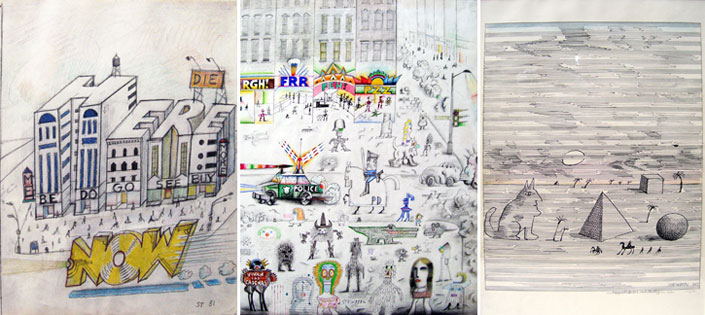Saul Steinberg at Adam Baumgold Gallery
"I AM BECAUSE I DRAW," MIGHT HAVE BEEN THE MANTRA OF SAUL STEINBERG (1914-1999), judging from the way he explored central issues of human existence. Identity, isolation, connection to our fellow humans, and the world at large - these are just some of the subjects that flowed as visual investigations from his pen. And it was linework that mainly defines his work, although he briefly delved into painting in the 1970s.
An exhibition currently up at Adam Baumgold Gallery, which in its depth and careful selection is a mini-retrospective in disguise, makes a perfect re-introduction to one of the 20th century's greatest iconoclasts. "The whole history of art influenced me;" Steinberg wrote, "Egyptian paintings, latrine drawings, primitive and insane art, Seurat, children's drawings, embroidery."
Because his interests were so broadly human, Steinberg's art was about the human experience as lived by people from all walks of life - which made his though-provoking art so approachable. In Bleecker Street (below) for example, each of the characters that throng to a Village intersection, from a militant biker type to a Mona Lisa-like beauty, is drawn in a style appropriate to his or her identity.

Left to right: Here, Now (cover for The New Yorker), 1981; Bleecker Street (cover for The New Yorker), 1971; Egypt, 1967. Courtesy Adam Baumgold Gallery.
If anything, Steinberg was an artist-monologist whose drawings were word pictures, in which letters often become personifications of ideas and ideas are personified by characters who proudly stride, sit, and ponder life on a sheet of white paper. Witty and ingenious, these pages become a celebration of the human capacity for sorting out the hard stuff. The boundless imagination with which Steinberg corralled the everyday into his intellectual though process is matched only by the variety of materials he brought into his highly literate arsenal of artistic devices.
Apart from sheets of brilliant white art paper are readymade surfaces on which he creates magical transmogrifactions of identity into art, such as birds stamped from his fingerprints that perch on a sheet of graph paper; or the musical notation page that, with the addition of his exactly-the-same-width ink lines, become a smoggy desert landscape in which his alter ego, a sphinx-like cat, contemplates a pyramid and its geometric cousins: a cube and a sphere.
Steinberg's cover art for The New Yorker is legendary, and a few pieces in the show are either the originals or variants for several of these. His training and life-long interest in architecture are the backbone of Here, Now, from 1981. Done in color, this almost actual-size sheet is a perfect bookend for a large-scale black-and-white drawing, The Drugstore, which he did in 1946 for a book called The Art of Living.
Inventory, from 1967, pretty nearly illustrates the opening line above. As well as being a catalogue of Steinberg's iconography, it is also an autobiographical depiction of the stuff that occupied him throughout that particular decade, from invented calligraphy to maps of fictional worlds to the circular calendar, carved in stone, that rolls uninvited into the artist's studio.
Saul Steinberg: Works from the 50s-80s continues at Adam Baumgold Gallery through May 8th. 60 East 66th Street, New York, NY. Tuesday-Saturday, 11-5:30. For more information about the artist, visit the Saul Steinberg Foundation website.
040210


